The age-old question of which countertop material is superior, solid surface vs laminate, has often been the center of heated debates among homeowners, interior designers, and remodelers. The real challenge lies in evaluating each countertop material’s features, pros, and cons and aligning them with your specific needs and budget.
The ideal countertop should not only enhance your kitchen’s aesthetic appeal but also provide functionality, durability, and longevity. Hence, this article delves deep into these two most popular countertop materials – solid surface and laminate – with an aim to shed light on their composition, benefits, drawbacks, and other vital aspects.
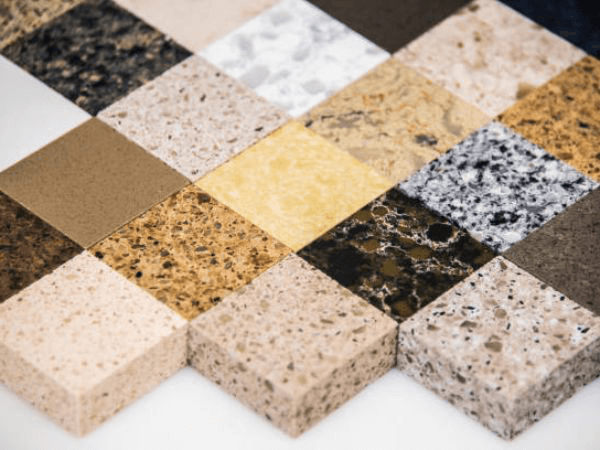
Understanding Solid Surface Countertops: Composition and Features
Solid surface countertops (Learn: How To Cut Solid Surface Countertops) have carved a niche for themselves as aesthetically pleasing and highly durable options in contemporary homes. They are engineered materials created by combining natural minerals like quartz dust with various resins and polymers, further colored based on design needs. Corian, a popular solid surface brand, is often used synonymously with this countertop type.
The unique composition enables solid-surface countertops to mimic other high-end materials like granite and marble sans the exorbitant price tag. What sets solid surface apart in the solid surface vs laminate game is its non-porous nature— offering unmatched stain resistance, invisible seams for a flawless finish, and the ability to withstand moisture without deteriorating.
Moreover, these counters can be molded into myriad shapes and sizes, encompassing twirls, swirls, and curves that wooden or natural stone countertops can’t recreate.

Pros and Cons of Solid Surface Countertops
Like a coin, solid surface countertops (Learn: What Is A Solid Surface Countertop) have two sides when it comes to their pros and cons. On the bright side, these countertops offer significant advantages over their laminate counterparts – they’re highly seamless, available in a wide array of colors and patterns, and facilitate unique kitchen designs incorporating flexible curves and swirls. They’re non-porous, resist stains, and can be paired with an undermount sink.
However, there are drawbacks to using solid surface countertops that buyers should be aware of. The most significant negatives are that they’re susceptible to scratches and can be easily burned at temperatures of 212°F and above. Moreover, they’re also viewed as the pricier option, generally ranging from 40 to 150 per square foot.
| Solid Surface Countertops | |
| Pros | Cons |
| Highly seamless design | Susceptible to scratches |
| Various choices for colors and patterns | Lower heat-resistance |
| Curves and swirls designs available | Higher price range |
| Non-porous and stain-resistant | |
| Compatible with under-mount sinks | |
Unveiling Laminate Countertops: Composition and Characteristics
Turning our attention to solid surface countertops, let’s delve into the composition and characteristics of laminate countertops. In the solid surface vs laminate equation, laminate countertops distinguish themselves through their cost-effectiveness and flexibility of design.
Essentially, they are constructed from a wooden core enveloped in multiple sheets of plastic-like veneer, lending the countertop its name – laminate. This plastic laminate veneer can be custom-printed in a variety of colors and patterns to match your kitchen countertops’ design aesthetics.
Importantly, the wooden core beneath the laminate surface is typically comprised of less expensive pressed wood variants like MDF or particleboard. Consequently, these countertops do not exactly shine in terms of strength when compared to authentic stone materials like granite or marble.
However, the heartfelt appreciation for laminate stems from its budget-friendliness and easy upkeep, making it a popular choice for many households, especially those prone to frequent design shifts.
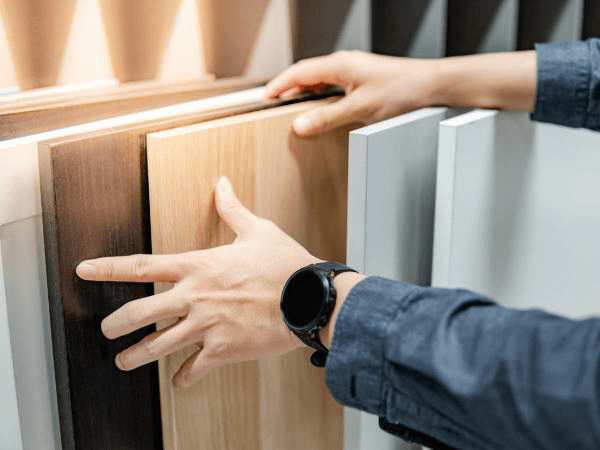
Pros and Cons of Laminate Countertops
The laminate countertop has its unique set of pros and cons. The most significant advantage is its affordability, with costs ranging from 10 to 30 per sq ft.
The low cost doesn’t limit design options; laminate countertops are available in an assortment of colors and patterns, some even mimicking the appearance of natural stone surfaces like granite and marble. They are notably stain resistant and can present a well-sealing surface when installed professionally.
However, speaking in terms of durability and heat resistance in the solid surface countertops vs laminate consideration, laminate falls short.
Often, they may appear “cheaper” due to the quality of materials used and are prone to damage from direct heat beyond 150°F. They also don’t offer the best defense against sharp implements, making them less than ideal for heavy-duty chopping or cutting.
| Laminate Countertops | |
| Pros | Cons |
| Affordable cost | Less durable |
| Variety of colors and patterns | Not heat resistant beyond 150°F |
| Can mimic natural stone surfaces | Prone to damage from sharp implements |
| Stain resistant | |
| Well-sealing surface when professionally installed | |
Durability Showdown: Solid Surface vs Laminate Countertops
When comparing solid surface vs laminate countertops, durability becomes a critical deciding factor. Solid surface, with its robust and non-porous nature, ranks high on durability. Conversely, laminate, targeted as a cost-effective solution, compromises on the resilience front. Regular wear and tear, exposure to extreme heat, or accidental spilling might cause laminate countertops to chip or peel off over time, necessitating periodic replacements or repairs.
Heat Resistance Comparison: Solid Surface vs Laminate
A vital comparison in the solid surface vs laminate debate is heat resistance. A countertop should ideally endure hot cookware without showing signs of damage. Unfortunately, both solid surface and laminate countertops exhibit certain limitations in this area.
Solid surface countertops exhibit greater heat resistance than laminate, withstanding temperatures up to 212˚F. However, anything hotter might result in scorching or discoloration.
Laminate countertops, on the other hand, boast considerably lower heat resistance—around 150˚F—and can blister or warp when exposed to high heat. For either material, the use of trivets or heat-resistant pads is recommended when placing hot pots or pans directly on the surface.
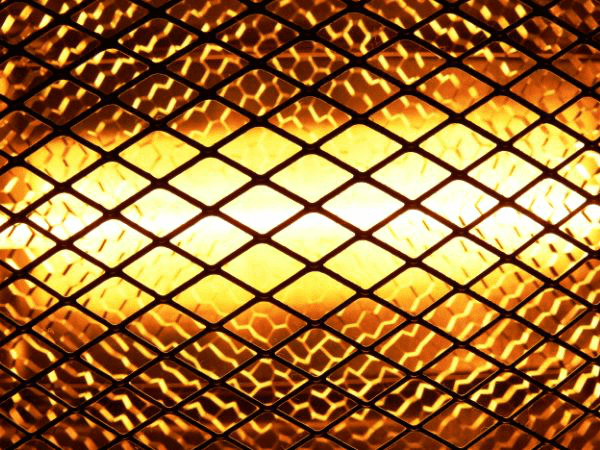
Solid Surface and Laminate Countertops: Which Is More Scratch Resistant?
Scratch resistance is another critical criterion within the solid surface vs laminate comparison framework. Solid surface countertops, despite their tendency to scratch, have an advantage—most scratches can be easily buffed out. As solid surface material is consistent throughout, minor abrasions are less noticeable and can be repaired readily to maintain aesthetics.
Conversely, laminate countertops have a layer-based structure, with the decorative surface adhered to the underlying wood. This construction makes laminate surfaces susceptible to deep scratches that expose the inner layers—something a quick buffing can’t fix. Concealing such scratches can prove challenging, and substantial damage might even require replacement.
Stain Resistance and Maintenance: Solid Surface vs Laminate
In the context of stain resistance and maintenance, solid surface countertops vs laminate present different attributes. Solid surface countertops, due to their non-porous nature, resist stains efficiently and can be cleaned with simple soap and water. In contrast, laminate countertops are largely staining-resistant, but stronger chemicals can cause damage.
For maintenance, solid surface countertops merely require occasional cleaning (Learn: Tips on How to Clean Solid Surface Countertops). Any scratches can be buffed and the surface can be refinished to retain its original glory. Meanwhile, laminate countertops, while easy to clean, may demand replacement in case of significant wear and tear.
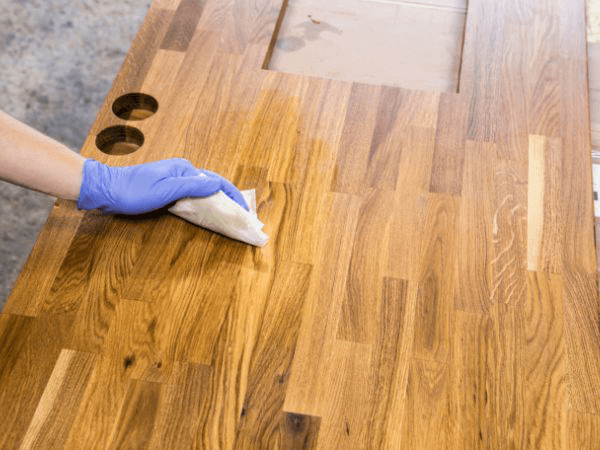
Customization Options: Colors, Patterns, and Designs
In the ongoing solid surface vs laminate comparison for countertop materials, customization is a key concern. Both categories offer a diverse palette of colors and patterns. Solid surface countertops can mimic luxurious materials like marble or granite, offering buyers the aesthetic charm of natural stone without the high cost. From single colors to multicolored swirls, specks, or granules – the design possibilities are extensive.
Laminate countertops too flaunt a broad spectrum of colors and patterns. They can reproduce the look of various materials like wood, metal, or even stone surfaces. This diversity enables homeowners to match the countertop design with their kitchen decor effortlessly.
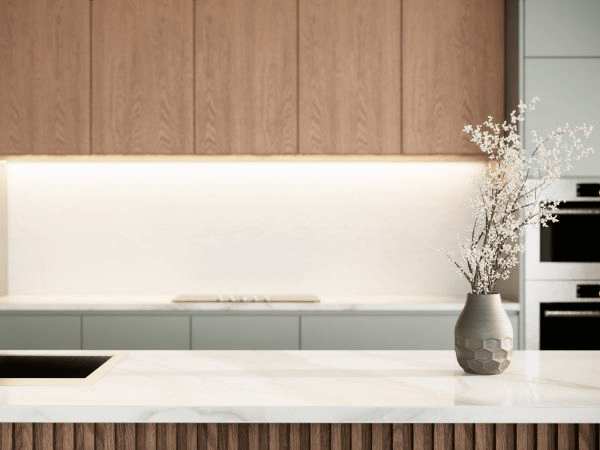
Aesthetics and Visual Appeal: Evaluating Solid Surface and Laminate Countertops
In the debate of aesthetics between solid surface countertops vs laminate, individual preference plays a crucial role. Solid surface countertops deliver a more high-end, seamless look that can elevate any kitchen’s appeal. With their capacity to mimic various natural stones, they can add a touch of sophistication to your space.
However, the laminate countertops aren’t far behind! With an array of colors and patterns, they offer decent aesthetic appeal. They can imitate more expensive materials, making them an economical alternative to getting a classy look on a budget. However, the seam along the edges, where the laminate sheet wraps around the countertop, might affect the overall look.
Cost Analysis: What’s the Price Difference Between Both Countertop Materials?
Cost is a paramount consideration in the solid surface vs laminate countertop materials debate. Solid surfaces tend to be pricier, ranging between 50 and 200 per square foot. The superior durability, aesthetics, and heat resistance largely justify its higher price.
Conversely, laminate countertops are among the most affordable options at 10-30 per square foot. However, their lower durability and susceptibility to damage may equate to higher long-term costs due to frequent repairs or replacements.

Longevity and Lifespan: Which Countertop Material Lasts Longer?
When assessing solid surface vs laminate countertops in terms of longevity, solid surfaces take home the trophy. With maintenance and care, solid surface countertops can last for decades. Their non-porous and homogeneous nature aids their durable lifespan whilst offering easy reparation of any damages incurred, giving you a countertop as good as new every time.
Laminate counters, while initially cost-saving, are susceptible to scratches, heat damage, and potential water harm over time. Despite the advantage of being easy to replace, the frequency of replacement needed due to its less durable nature might accumulate costs over time.
Environmental Impact: Sustainable Aspects of Solid Surface and Laminate
More than ever, consumers today are seeking environmentally friendly products. In the “laminate vs solid surface” debate, both materials present different ecological implications.
Solid surface countertops are often a blend of natural minerals and acrylic resins. While some brands offer options with recycled content, it’s essential to note that the manufacturing process can be energy-intensive. Additionally, although solid surfaces are long-lasting, they are not biodegradable but can be recycled in some cases.
Laminate countertops, composed of layers of paper and resins over a wood particle board, may contain recycled materials and are lightweight, reducing the CO2 emissions linked to their transportation. However, once past their service life, they might end up in a landfill as their recycling can be challenging due to the mix of materials.
DIY Installation and Repair Considerations: Solid Surface vs Laminate Countertops
Whether you opt for a solid surface or laminate countertop, installation, and repair considerations should play a role in your decision. Solid surface countertops often require professional installation due to their weight and custom fabrication. When it comes to repair, a solid surface can be refinished by sanding and buffing, making it an enduring choice.
On the other hand, laminate countertops are lighter, making their installation generally easier and well-suited to DIY projects. However, repairing a laminate countertop can be challenging, especially if the damage is beyond the surface layer. In many instances, replacement of the countertop or section may be the only viable option.
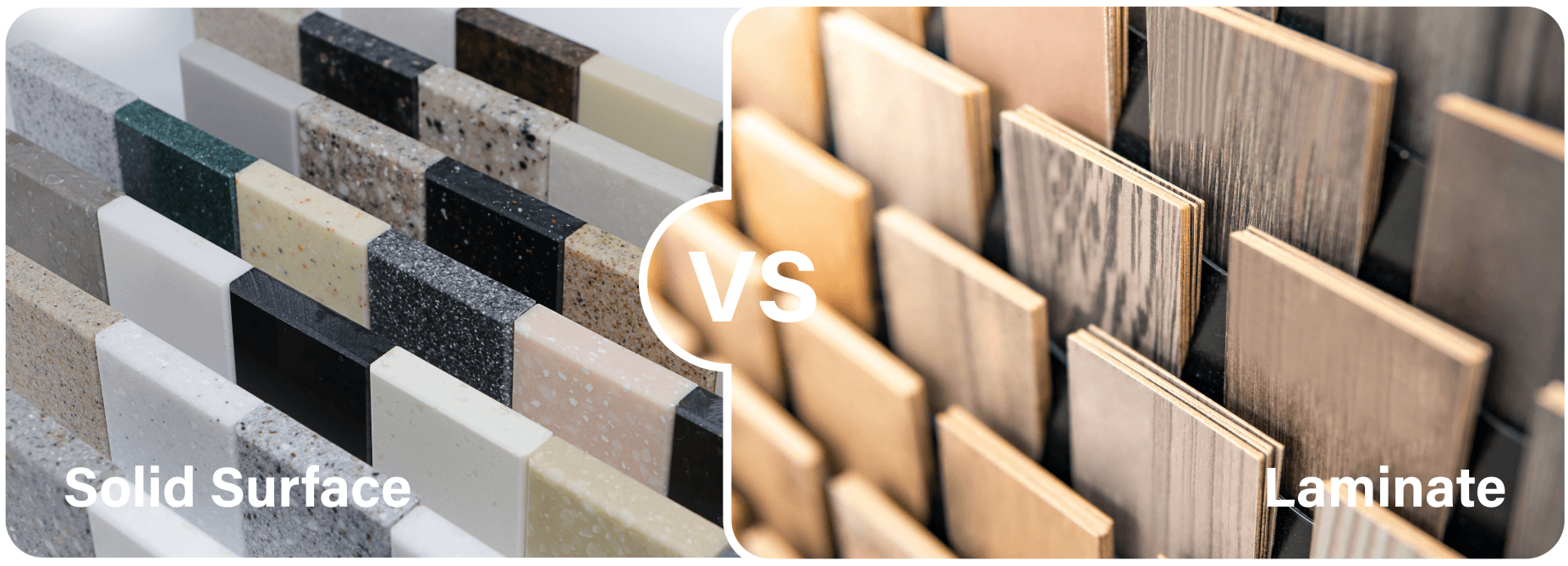
Conclusion: Making the Right Choice for Your Countertop Needs
To conclude our analysis, the choice between a solid surface and laminate countertops largely depends on your specific requirements, budget, and personal taste. While solid surface countertops offer robust durability, low maintenance, and a more luxurious look, laminate countertops stand out for their cost-effectiveness and versatile design options.
In the quest for getting the best value for your money, it’s essential to consider both initial costs and the long-term implications of your choice. Whether you prefer the timeless beauty of a solid surface or the cost-effective functionality of laminate, both materials offer unique benefits suitable for transforming your kitchen space.
See More Countertop Comparisons Blog Below
Corian vs Granite: A Comparison to 8 Important Differences
Solid Surface vs Quartz Countertops: What’s the Difference?



